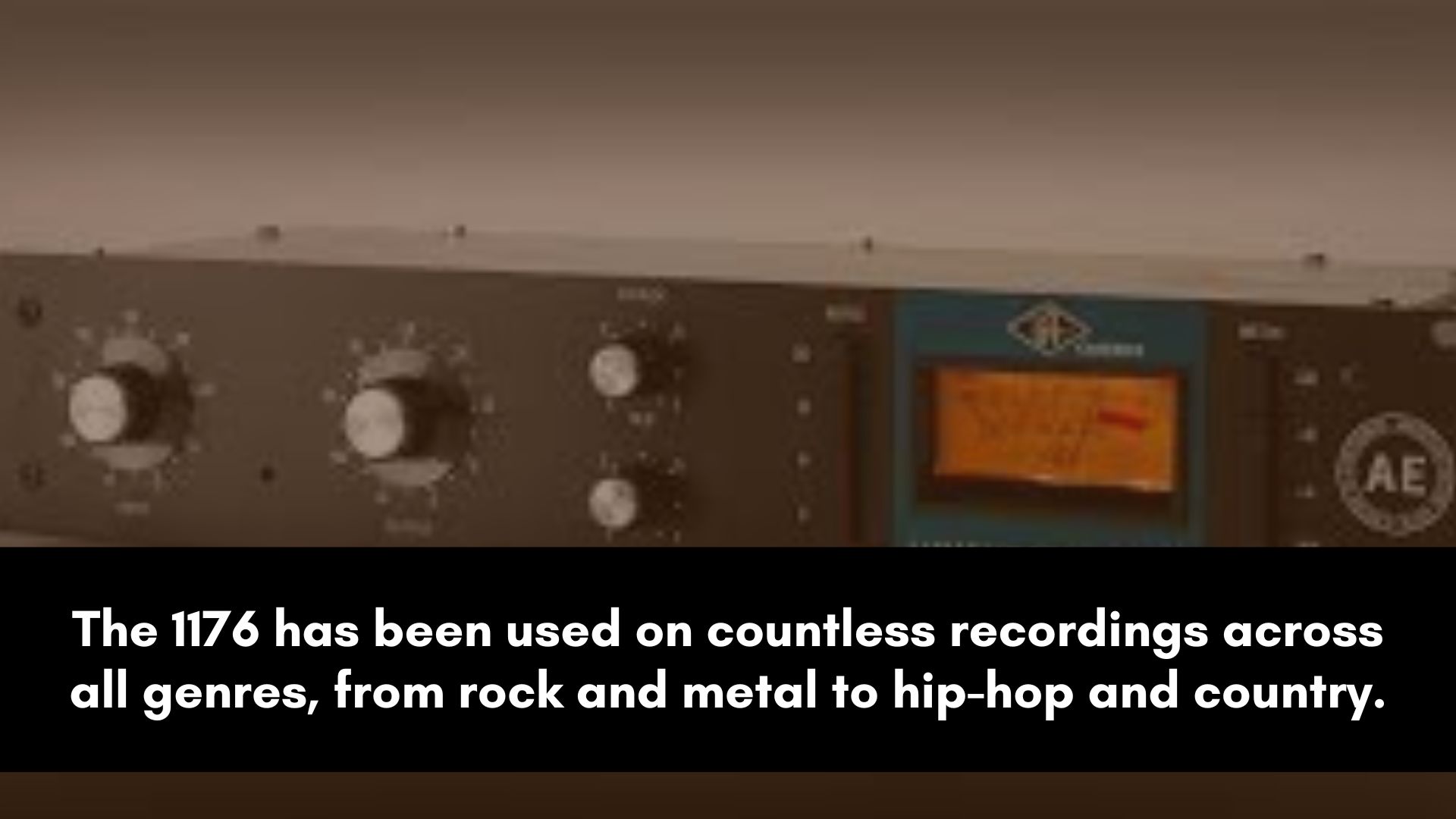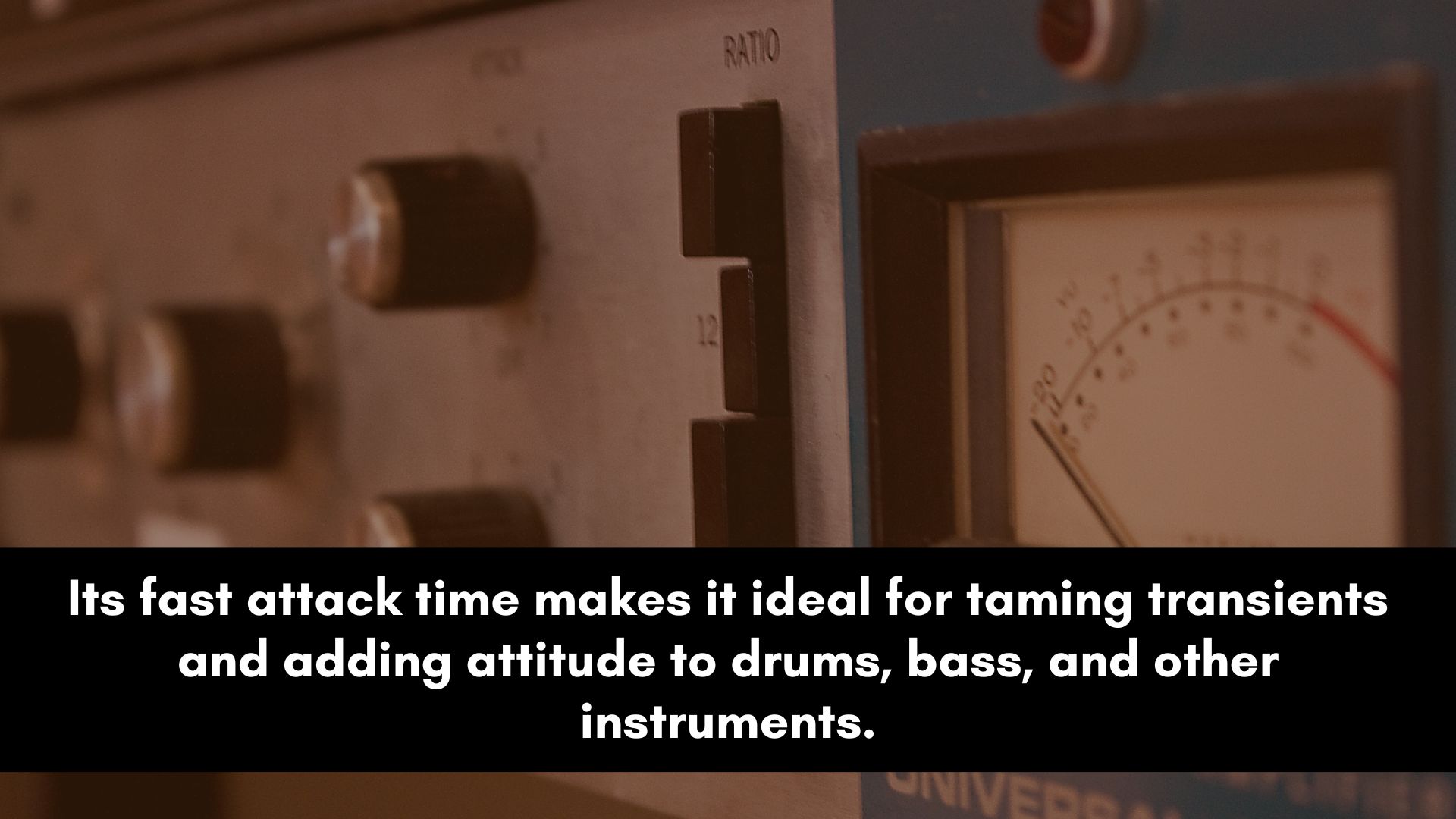If you're a music producer or an audio engineer, then you're likely familiar with the legendary 1176 compressor.
This iconic piece of equipment has been used on countless recordings over the years, and its distinct sound has become a staple of modern music production.
Today we'll take a closer look at the history, design, and unique features of this iconic compressor.
History of the 1176 Compressor

The 1176 compressor was first introduced by Universal Audio in 1967.
It quickly became a favorite among recording engineers for its fast attack time, presence, and ability to add coloration to recordings.
The 1176 was also one of the first solid-state compressors on the market, making it a game-changer for the industry.
The 1176 compressor is an iconic piece of audio equipment that has been used in countless recordings since its introduction in 1967.
Prior to its release, most compressors used vacuum tubes in their gain reduction circuits.
While vacuum tube compressors had a warm, pleasing sound, they were also prone to distortion and had a slow attack time.
The 1176, on the other hand, used FETs (Field Effect Transistors) instead of vacuum tubes, which gave it a more precise sound with a much faster attack.
One of the unique features of the 1176 is its fixed-ratio design with four selectable ratios: 4:1, 8:1, 12:1, and 20:1.
Over the years, it has become a staple of modern music production. Its distinctive sound has been used on countless recordings across all genres, from rock and metal to hip-hop and country.
The compressor's versatility and ability to add coloration to recordings have made it a favorite among engineers and producers who are looking to add character and presence to their mixes.
To this day, it remains one of the most popular compressors on the market.
Its timeless design and unique sound have made it a favorite among audio professionals and a must-have tool for any serious studio.
Whether you're tracking drums, smoothing out vocals, or adding sustain to guitar solos, the 1176 is a versatile and powerful tool that can help take your recordings to the next level.
Its Strengths and Weaknesses
Just like any other classic piece of audio equipment, it has many strengths and some weaknesses.
Strengths:
- Fast attack time: This makes it an excellent choice for controlling transients and adding punch to percussive instruments like drums.
- Versatile: The 1176 can be used in a variety of applications in music production, from vocals to drums to guitar.
- Classic sound: It has been used on countless recordings over the years, giving it a classic sound that many engineers and producers love.
- Easy to use: The few controls make it simpler to use and get the desired sound much quicker.
Weaknesses:
- Limited control: This can be both an advantage and a drawback for tonal compression. For instance, you can achieve low ratio settings or slow attack times.
- No sidechain: It doesn’t have a sidechain input, which can limit its usefulness in certain applications, such as de-essing and bus compression.
- Coloration: While the 1176's coloration can be a strength, it can also be a weakness in some applications where a more transparent sound is desired.
- Expensive: It can be quite expensive, especially if you are looking to purchase a vintage unit.
While it has some limitations, its strengths make it a favorite among many engineers and producers.
Commonly Asked Questions
Here’s a list of frequently asked questions that beginner engineers and producers often have about the legendary 1176.
Who Made the Original 1176 Compressor?

The original 1176 compressor was designed by Universal Audio's founder, Bill Putnam Sr.
Putnam was a pioneer in the audio industry and was known for his innovative designs and contributions to the field of recording.
He also designed other classic pieces of equipment, including the LA-2A compressor and the 610 console.
What is it Good For? (Including Practical Examples)

The 1176 compressor is a versatile piece of equipment that can be used in a variety of settings.
Its fast attack time makes it ideal for taming transients and adding attitude to drums, bass, and other instruments.
It's also great for smoothing out vocals and adding sustain to guitar solos.
The 1176 can be used in both tracking and mixing stages, making it a must-have for any serious studio.
Here are a few practical examples of how to use the 1176 compressor:
- Vocals: It’s a popular choice for vocal compression because of its fast attack time and ability to add warmth and character to a voice. By using a moderate ratio and setting the attack and release times appropriately, you can control the dynamics of the vocal performance without squashing it.
- Drums: It is very useful on individual drums, such as kick and snare, to add punch and sustain. By using a higher ratio and a fast attack time, you can control the transient peaks and add sustain to the drum hits.
- Bass: The 1176 can be used on bass guitar to add weight and definition to the sound. By using a moderate ratio and slow release, you can control the dynamics of the bass performance and add sustain to the notes.
- Guitars: It can sound amazing on guitars as well. By setting the ratio to 4:1 with a fast attack and medium release, you can control the dynamics, add warmth, and add a smooth, compressed sound to your guitar performance.
Overall, the 1176 compressor is a versatile and powerful tool that can be used in a variety of applications in music production.
Its unique sound and fast attack time make it a popular choice for controlling dynamics and adding presence and warmth to recordings.
What Kind of Compressor is the 1176?
The 1176 is a FET (Field Effect Transistor) compressor, which means that it uses FETs instead of vacuum tubes for its gain reduction circuit.
This gives it a unique character that's different from other compressors on the market.
It also has a fixed-ratio design with four selectable ratios: 4:1, 8:1, 12:1, and 20:1.
What is the Difference Between Black and Blue Model?

There are two main versions of the 1176 compressor: the "blackface" and the "bluestripe."
The blackface version was the original design and features black knobs and a black faceplate.
The blue-stripe version was introduced later and features blue knobs and a blue stripe on the faceplate.
The black 1176 was the original design and was produced from 1967 to 1970.
It has a more aggressive sound than the blue revision, with a faster attack time and more pronounced midrange.
The black 1176 also has more distortion and coloration than the blue revision, which can add character and warmth to a recording.
Many engineers and producers prefer the black 1176 for its aggressive sound and character.
The blue 1176 was produced from 1970 to 1973 and has a slightly different sound than the black version.
It has a smoother sound with a slower attack time, making it more transparent and less aggressive than the black 1176.
The blue 1176 also has less distortion and coloration than the black revision, which can make it a better choice for certain applications where a more transparent sound is desired.
However, some engineers find the blue 1176 to be less interesting than the black version due to its smoother sound.
Both versions are classics in their own right and have been used on countless recordings over the years.
Some engineers prefer the aggressive sound and character of the black 1176, while others prefer the smoother, more transparent sound of the blue version.
What is the Knee on the 1176?
The 1176 has a "hard knee" design, which means that the compressor starts working immediately as the signal crosses the threshold.
This can be useful for controlling transients and adding punch to drums and other percussive instruments.
In conclusion, the 1176 compressor is a classic piece of equipment that has earned its place in the pantheon of recording gear.
It has been a favorite for over 50 years and a must-have tool for any serious studio.